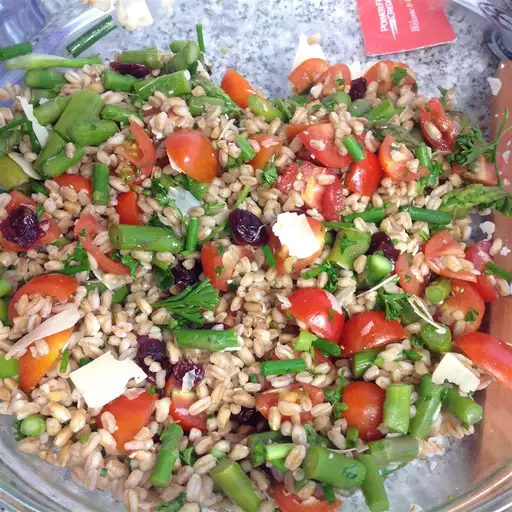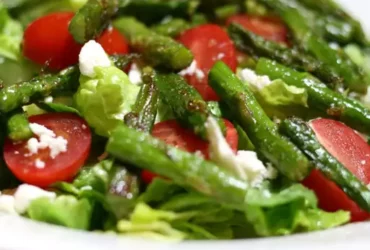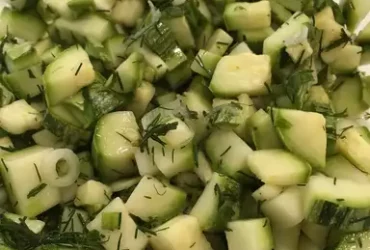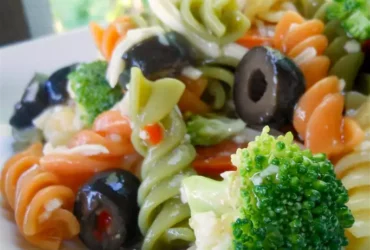Ingredients
Farro Salad Components
- The key to a great Farro salad lies in the quality and combination of its ingredients. For this recipe, we will be using:
- Farro, an ancient Italian grain that is high in fiber and nutrients. It has a nutty flavor and chewy texture that pairs perfectly with the sweetness of the asparagus.
- Asparagus, which adds natural sweetness, crunch, and freshness to the salad. Fresh or blanched asparagus can be used, depending on your preference.
- Parmesan cheese, a classic Italian ingredient that adds salty, nutty flavor and creamy texture to the dish. You can use freshly grated Parmesan for the best results.
- A lemon vinaigrette, made with lemon juice, olive oil, garlic, salt, and pepper. This dressing brings all the flavors together and adds a tangy touch to the salad.
- Chopped fresh herbs such as parsley, basil, or mint can be added for extra flavor and color. Choose one herb that complements the other ingredients and add it in moderation.
- Optional ingredients include cherry tomatoes, red onion, avocado, or grilled chicken. Feel free to customize the salad to your taste by adding or substituting different ingredients.
1 cup farro grains
- Farro grains are a key ingredient in this recipe, providing a nutty flavor and chewy texture to the salad. One cup of farro grains is a good amount for serving 4-6 people, depending on serving size.
- Farro is an ancient grain that is high in fiber, making it a nutritious addition to the dish. It has a slightly sweet and earthy taste, which complements the bitterness of the asparagus and the saltiness of the Parmesan cheese.
- When selecting farro grains, look for them at your local health food store or specialty grocery store. You may be able to find them in the bulk bin section or packaged in a bag with other ancient grains. If you can’t find farro grains, you can also try using spelt or bulgur as a substitute.
- Before cooking the farro grains, make sure to rinse them thoroughly and pick out any debris or stones that may be mixed in. You want to remove any impurities from the grain before cooking it so that it cooks evenly and has the best flavor possible.
- To cook the farro grains, bring a large pot of water to a boil and then add 2-3 cups of water for every one cup of farro grains you are using. Bring the water back to a boil and then reduce the heat to low and simmer for about 20-25 minutes or until the grain is tender but still has some bite.
- While the farro grains are cooking, prepare the asparagus by trimming off the ends and cutting it into 1-inch pieces. Place the asparagus on a baking sheet lined with parchment paper and drizzle with olive oil, salt, and pepper. Roast in the oven at 425°F (220°C) for about 12-15 minutes or until tender and lightly browned.
- Once the farro grains are cooked, let them cool to room temperature before using them in the salad. This will help them absorb all of the flavors from the other ingredients.
- To assemble the salad, combine the cooled farro grains with the roasted asparagus, crumbled Parmesan cheese, chopped fresh parsley, and a drizzle of olive oil and lemon juice. Toss everything together gently so that each bite has a good balance of flavors and textures.
2 cups water or vegetable broth for cooking
The ingredients used to cook the 2 cups water or vegetable broth in the Farro Salad with Asparagus and Parmesan Recipe play a crucial role in preparing this dish. Here’s a breakdown of what you’ll need:
For the cooking liquid, you can use either water or vegetable broth. Both options are suitable for cooking the farro and will add flavor to your final salad. If you prefer a clearer broth, you may want to choose the vegetable broth option.
- 2 cups Water
- or 2 cups Vegetable Broth
You can use either of these options as a substitute for one another in the recipe. This flexibility allows you to adjust the flavor and texture according to your personal preference.
The amount of cooking liquid used is based on the type of farro you are using. If you’re unsure about which option to choose, you can start with 2 cups of water or vegetable broth and adjust accordingly as needed.
1 pound fresh asparagus, trimmed
For this Farro Salad with Asparagus and Parmesan recipe, you will need 1 pound of fresh asparagus, which has been trimmed to prepare it for cooking.
The trimming process typically involves removing any tough or woody ends from the bottom of each spear, as well as cutting off any discolored or damaged tips.
This is an important step in preparing the asparagus because it helps to remove any parts that may be difficult to digest or unpleasant in texture.
Here are some specific steps for trimming 1 pound of fresh asparagus:
- Cut off about 1 inch from the bottom end of each spear, where the stem begins to thicken.
- Remove any leaves that are bunched together at the top of the spear, leaving just a small cluster of delicate tips.
- Cut off any discolored or damaged ends, making sure to remove any areas with visible signs of mold or rot.
After trimming your asparagus, you should be left with clean, tender spears that are ready to use in the Farro Salad with Asparagus and Parmesan recipe.
1/2 cup grated Parmesan cheese
The key to making this farro salad truly shine is in its ingredients, particularly when it comes to the Parmesan cheese. In this recipe, we’re calling for 1/2 cup of grated Parmesan cheese.
This amount may seem modest, but trust us – it’s just right. Too much Parmesan can overpower the delicate flavors of the farro and asparagus, while too little won’t provide enough depth to the dish.
When shopping for Parmesan, look for a high-quality block or wheel that’s been aged to perfection. You’ll know you’ve got good stuff when it’s firm to the touch, with a nutty aroma and a slightly crumbly texture.
Now, onto the grating process! Using a box grater or a Microplane, carefully grate the Parmesan cheese into fine shreds. Be gentle – you want to avoid ending up with a pile of dusty, flour-like powder instead of creamy, stringy strands.
To make this grated cheese truly sing, be sure to use it within a few hours of grating. If you’re prepping ahead for the salad, consider storing the Parmesan in an airtight container in the fridge until serving time.
Additional ingredients (choose one)
The key ingredients for this recipe include farro, asparagus, parmesan cheese, lemon juice, olive oil, garlic, salt, and pepper. These ingredients come together to create a delicious and healthy salad that is perfect for springtime.
Farro is the main grain in this recipe, providing a nutty flavor and chewy texture to the dish. It can be found at most health food stores or well-stocked supermarkets.
Asparagus is the primary vegetable in this recipe, adding a burst of freshness and flavor to each bite. Fresh asparagus is available during the spring and summer months, but frozen or canned varieties are also options for other times of year.
Parmesan cheese adds a salty, savory flavor to the salad, complementing the nutty taste of the farro and the earthy sweetness of the asparagus. You can use either freshly grated or pre-shredded parmesan in this recipe.
Lemon juice is used to brighten the flavors in this dish, adding a touch of acidity to balance out the richness of the cheese. Freshly squeezed lemon juice is preferred for its intense flavor and aroma.
Olive oil is used as the base oil for the dressing in this recipe, providing a smooth and silky texture that coats each bite evenly. Choose a high-quality olive oil with a mild flavor to avoid overpowering the other ingredients.
Garlic adds a depth of flavor to the salad, but be careful not to overdo it – a small amount will suffice. You can either mince fresh garlic or use pre-minced garlic for convenience.
Salt and pepper are used to enhance the flavors in this dish, bringing out the best qualities of each ingredient. Use kosher salt and freshly ground black pepper for optimal flavor.
1 small red onion, thinly sliced
The first ingredient, which adds a pungent flavor to the Farro Salad , is a small red onion, thinly sliced.
When selecting an onion for this recipe, look for one that has a compact shape and a firm texture. This will ensure that it holds its shape when thinly sliced and doesn’t fall apart in the salad.
The peel of the onion should be thin and even, without any visible signs of damage or sprouting. Avoid onions with soft spots or cracks, as these can be a sign of rotting.
Choose an onion that is sweet rather than one that has a strong flavor. The sweetness will balance out the savory flavors in the salad and prevent it from becoming too overpowering.
To thinly slice the onion, use a sharp knife or a mandoline to achieve uniform slices. Slice the onion at an angle to get longer slices, rather than cutting it straight up and down.
1/2 cup chopped fresh parsley
The ingredients required to prepare the delicious Farro Salad with Asparagus and Parmesan include several key components that will enhance its flavor and texture.
One of the primary ingredients in this recipe is chopped fresh parsley, which serves as a vital component in adding freshness and aroma to the dish. A total of 1/2 cup of chopped fresh parsley is required for this recipe.
To achieve the optimal level of freshness and flavor, it’s crucial to select high-quality parsley leaves that are crisp, green, and have no signs of wilting or browning.
The best way to chop the parsley is by using a sharp knife, cutting it into fine pieces that can be evenly distributed throughout the salad. This will ensure that each bite has the perfect balance of flavors and textures.
When working with fresh herbs like parsley, it’s essential to handle them gently to avoid bruising or damaging the leaves, which can cause them to lose their flavor and aroma.
The 1/2 cup of chopped fresh parsley will be used in conjunction with other ingredients such as farro, asparagus, Parmesan cheese, lemon juice, olive oil, garlic, salt, and pepper to create a delicious and well-balanced Farro Salad with Asparagus and Parmesan.
Instructions
Cooking the Farro
To cook farro according to this recipe, follow these steps:
- Rinse the farro in a fine-mesh strainer under cold running water.
- In a large pot, combine the rinsed farro and enough water to cover it by about an inch. Bring the water to a boil over high heat.
- Once boiling, reduce the heat to low, cover the pot with a lid, and simmer for about 20-25 minutes, or until the farro is cooked through and has a slightly chewy texture.
- Drain the cooked farro in a fine-mesh strainer under cold running water to stop the cooking process. This will also help the farro to cool down quickly and prevent it from becoming mushy.
Alternatively, you can cook the farro using the package instructions. However, please note that cooking times may vary depending on the type of farro you are using.
For example, according to Bob’s Red Mill Farro package instructions:
- To cook farro from scratch (uncooked): Rinse and soak in cold water for 8 hours. Drain and cook as usual.
- To reheat pre-cooked farro: Bring to a boil, reduce heat to low and simmer for about 5-7 minutes, or until heated through.
Once the farro is cooked, it’s ready to be mixed with other ingredients in this Farro Salad with Asparagus and Parmesan recipe. Be sure to follow the ingredient list and instructions carefully to create a delicious and well-balanced salad.
Rinse farro in a fine mesh strainer and drain well.
- Rinsing farro, a type of Italian grain, before cooking is an important step to ensure it cooks evenly and has good texture.
- To rinse the farro, start by placing it in a fine mesh strainer under cold running water.
- The strainer allows for even rinsing without washing away any of the farro itself.
- Rinse the farro for about 30 seconds to one minute, stirring occasionally to make sure all grains are exposed to the water.
- This step helps remove any impurities or debris that may have accumulated on the grains during processing or storage.
- After rinsing, drain the farro well in the strainer to remove excess moisture.
- This is an important step to prevent a mushy or soggy texture in the cooked farro.
- Once drained, you can proceed with cooking the farro according to your recipe, which in this case is likely part of the Farro Salad with Asparagus and Parmesan Recipe.
Benefits of Rinsing Farro
- Even cooking
- Better texture
- Removal of impurities and debris
In a medium saucepan, bring 2 cups of water or vegetable broth to a boil.
When it comes to creating a delicious dish like Farro Salad with Asparagus and Parmesan, following precise instructions is crucial for achieving the desired flavors and textures.
The first step in this recipe involves preparing the farro, which requires rinsing it under cold running water and draining well. This simple action helps remove any impurities or debris that may be attached to the grains.
Next, cook the farro according to the package instructions, typically by bringing a certain amount of water to a boil and then reducing heat for a specified time period. The package should provide clear guidelines on how long to cook the farro, usually around 20-25 minutes, until it reaches the desired level of doneness.
While the farro is cooking, prepare the asparagus by trimming off any tough or woody ends and cutting into bite-sized pieces. This helps distribute heat evenly during roasting and ensures each piece cooks thoroughly.
To add flavor to the dish, sauté sliced garlic in a pan with olive oil over medium heat until fragrant. This step is essential for releasing the flavors of the garlic and creating an aromatic base for the salad.
Once the farro has finished cooking, allow it to cool slightly before fluffing it with a fork or spoon. This helps prevent breakage and maintains the texture of the grains.
Now, in a medium saucepan, bring 2 cups of water or vegetable broth to a boil. The addition of a flavorful liquid at this stage will help enhance the overall taste and aroma of the dish as it cooks the farro to perfection.
To create the dressing for the salad, whisk together olive oil, lemon juice, salt, and black pepper in a small bowl until well combined. This mixture should be smooth and emulsified, ready to be tossed with the cooked farro and roasted asparagus.
Add rinsed farro to boiling water; cover, reduce heat, and simmer for 2025 minutes or until al dente.
Farro is a type of Italian grain that can be used as a base for various salads, including the popular Farro Salad with Asparagus and Parmesan. To cook farro, follow these steps:
Step 1: Cooking Farro
- Add rinsed farro to boiling water.
- Cover the pot with a lid to trap heat and prevent excess evaporation.
- Reduce the heat to a simmer.
- Simmer for 20-25 minutes or until the farro is al dente. Al dente means that the farro should still have some firmness in the center, but not be crunchy.
Why Cooking Time Varies
The cooking time of farro can vary depending on several factors, such as the type of farro used, its age, and how it was stored. Generally, semi-pearled or pearled farro will cook faster than whole grain farro.
How to Check Doneness
- Check the farro periodically during cooking by tasting a small amount.
- If the farro is cooked through but still has some texture, it’s done. If it’s mushy or raw, continue cooking for a few more minutes and check again.
Tips for Cooking Perfect Farro
- Use a large pot with plenty of water to prevent the farro from becoming sticky and clumping together.
- Don’t overcrowd the pot, as this can cause the farro to cook unevenly. Cook in batches if necessary.
After cooking the farro, it’s ready to be mixed with other ingredients to create the Farro Salad with Asparagus and Parmesan. This salad is a delicious and refreshing springtime dish that showcases the flavors of Italy. Simply toss cooked farro with blanched asparagus, grated Parmesan cheese, and a light vinaigrette for a healthy and flavorful meal.
Tips and Variations
Adding Flavor
- Tips and Variations: This recipe offers a versatile base for experimentation, allowing you to adapt it to your taste preferences and ingredient availability.
- Farro Salad with Asparagus and Parmesan can be enjoyed as a light lunch or dinner option. For an added protein boost, consider incorporating grilled chicken, salmon, or tofu into the mix.
- To elevate the flavors, try adding some aromatics like sautéed onions, garlic, or mushrooms to the farro and asparagus mixture. You can also sprinkle in some chopped fresh herbs such as parsley, basil, or thyme for added freshness.
- If you prefer a creamier salad, consider adding a dollop of yogurt or a sprinkle of Parmesan cheese on top. Alternatively, you can try using different types of cheese like feta or Gorgonzola for varying flavor profiles.
- To make the salad more substantial, add some chopped nuts or seeds such as pistachios, almonds, or pumpkin seeds. This will not only provide crunch but also a boost of healthy fats and protein.
- For a vegan version, substitute the Parmesan cheese with nutritional yeast, which has a similar nutty flavor and can be used as a dairy-free alternative.
- This recipe is also an excellent opportunity to use seasonal ingredients. Feel free to swap out the asparagus for other spring vegetables like peas, radishes, or spinach.
Once the asparagus is tender, season with salt and pepper.
To elevate this simple yet flavorful Farro Salad with Asparagus and Parmesan recipe, consider incorporating various tips and creative variations to make it a standout dish for any occasion.
One way to enhance the flavor of the asparagus is to add aromatics such as garlic or shallots before sautéing. Simply mince 1-2 cloves of garlic or 1/4 cup of finely chopped shallots and mix with olive oil, salt, and pepper. Then, toss in the asparagus tips and cook until tender.
Another option is to use different types of cheese instead of Parmesan. For a nuttier flavor, try using Grana Padano or Pecorino Romano. If you prefer a creamier taste, substitute with Mascarpone or Burrata. Experimenting with various cheeses will not only change the flavor profile but also provide a delightful texture contrast.
To add some crunch to the salad, consider incorporating chopped nuts or seeds such as almonds, pine nuts, or sesame seeds. These can be toasted in a pan with olive oil and seasoned with salt until fragrant and crispy.
For an added pop of color, toss in some cherry tomatoes or sliced red onions. The sweetness of the tomatoes pairs well with the earthy taste of the asparagus, while the pungency of the onions adds depth to the dish.
Beyond traditional ingredients, think about using unique flavor combinations to make this Farro Salad with Asparagus and Parmesan recipe your own. Consider adding some dried herbs like thyme or rosemary for a Mediterranean twist, or incorporate citrus elements such as lemon zest or orange segments for a bright and refreshing taste.
Add a squeeze of fresh lemon juice to brighten the flavors in your salad.
- Add a squeeze of fresh lemon juice to brighten the flavors in your salad, just as you would when making a caprese salad.
- You can also add some chopped fresh herbs like parsley, basil, or mint to give the salad a bit more freshness and flavor.
- Consider adding some other ingredients that will complement the flavors of the farro, asparagus, and Parmesan such as cherry tomatoes, sliced red onion, or diced bell peppers.
- To make the salad a bit more substantial, you can add some protein sources like cooked chicken, salmon, or tofu.
- If you want to add some crunch to your salad, try adding some toasted chopped nuts or seeds like almonds, pumpkin seeds, or sunflower seeds.
- For an Italian twist on the salad, try adding some sliced prosciutto or pancetta for a salty and savory flavor.
- You can also toast some garlic and then chop it up to add to the salad for extra depth of flavor.
- Add some grated ginger to give the salad a bit of spice and warmth.
- For a creamy version of the salad, try adding some crumbled goat cheese or ricotta cheese instead of Parmesan.
Try mixing in some chopped mint or basil for added depth in your farro salad.
To take your Farro Salad with Asparagus and Parmesan to the next level, consider incorporating some creative twists and variations to give it a unique flavor profile.
One way to add an extra layer of depth to your salad is by mixing in some chopped herbs, such as fresh mint or basil. The bright, refreshing flavor of these herbs complements the earthy taste of farro perfectly and adds a delightful contrast to the sweetness of the asparagus.
For an Italian-inspired take on this recipe, you can sprinkle some extra Parmesan cheese on top of your salad before serving. This will add an even richer, nuttier flavor to your dish and satisfy any cheese lover’s cravings.
To make your Farro Salad with Asparagus and Parmesan a bit more substantial, consider adding some Cooked Chicken or Shrimp. Simply sauté the protein of your choice in a little olive oil until cooked through, then toss it into your salad along with the other ingredients.
For an added crunch element to your dish, try sprinkling some toasted pine nuts or chopped almonds on top of your salad. The nutty flavor and satisfying texture will add another dimension to this delicious recipe.
Lastly, if you’re feeling adventurous, consider experimenting with different types of cheese in place of the traditional Parmesan. Some other options include crumbled goat cheese or a creamy feta – both of which will add unique and exciting flavors to your Farro Salad with Asparagus and Parmesan.
- Best Clay Alternatives for 2025 - April 22, 2025
- Best Leadfeeder Alternatives for 2025 - April 22, 2025
- Best Snov.io Alternatives for 2025 - April 21, 2025















